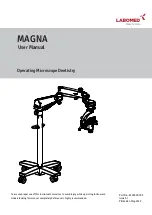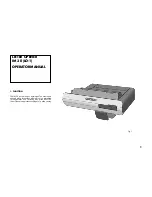
8(12)
6.1.
Operation
Check the operating area before using the digger:
•
Check that bystanders are at safe distance from the equipment. Do not let others
to stay closer than five meters from the equipment, the boom danger area or
directly in front of the loader.
•
Make sure that there are no electric cables, water lines or similar obstacles within
the reach of the equipment.
Beware of the caving in hazard in the excavation or near it. Do not drive near the edge
of the hole or allow children to play near it.
The mini digger is operated with the auxiliary hydraulics control lever of the loader. On 200-series loaders,
the control device is a pedal on the left and on other models a lever. If the operation of the bucket seems
illogical for you, you can change the connection of the hydraulic hoses.
Digging with the mini digger is the most efficient when the edge of the bucket is kept at an angle that allows
the edge to cut the soil the most effectively. The bucket should not be pressed too hard downwards, since
this would result in lifting the front tires of the loader, and digging becomes ineffective. Pull the edge of the
bucket towards the loader. When the bucket has been filled by pulling, close the bucket, and move the
material to the side by turning or driving with the loader.
7.
Inspections, maintenance and servicing
Continuous maintenance includes regular cleaning and lubrication of the equipment. The condition of the
hydraulic hoses and components should be monitored. Due to crushing hazard caused by the movements of
the loader boom and the digger bucket, all maintenance work must be done when the attachment has been
lowered on the ground and the residual pressure has been released.
All maintenance procedures must be performed when the digger and the loader boom have
been lowered down completely. The boom may lower by itself causing serious injuries.
Check the condition of the hydraulic hoses and components when the engine has been turned off and the
pressure has been relieved. Repair all leaks immediately after detecting them; a small leak can quickly grow
into a big one. Do not use the equipment, if you have discovered a fault in the hydraulic system. Leaking
hydraulic fluid may penetrate the skin and cause serious injuries. Hydraulic fluid is also harmful to the
environment.
Check hoses visually for cracks or abrasions. Monitor the wearing of the hoses and stop the use, if the
surface layer of the hose has worn off. If there are signs of leaking, to check the component, hold up a piece
of cardboard in the area where a leak is suspected. Finding any of these faults means that the hydraulic
hose or component in question must be replaced. Spare parts are available from your nearest AVANT
retailer or service point.
Never tighten a hydraulic fitting under pressure,
since the fitting may break and the released oil
may cause serious injuries. Do not use the
equipment, if you have discovered a fault in the
hydraulic system.
Summary of Contents for A32393
Page 12: ......






























